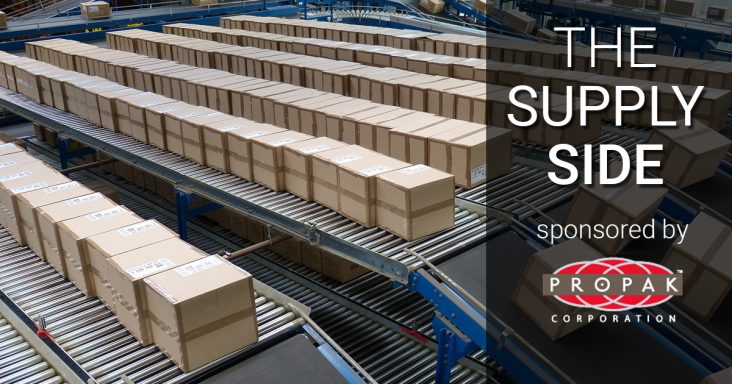The Supply Side: Retailers grapple with widespread inventory glut in recent quarter
by June 26, 2022 12:35 pm 3,115 views

It’s been a feast or famine for many retailers in the past two years amid supply chain challenges resulting from the COVID-19-induced global shutdown in 2020 to the Russian invasion of Ukraine that has resulted in a sluggish and more expensive supply chain.
Last month, Walmart surprised investors when it reported 32% higher-then-expected inventory for the first quarter ending Feb. 1. Costco said inventories were up 26% from the previous year, and Target saw inventories up 43% against a 4% revenue gain in its recent quarter.
The cost of carrying extra inventory took a toll on company revenues for the recent quarter. The inventory glut was widespread across the retail landscape with a 17% gain at Macy’s, 40% inventory growth at Kohl’s and Dick’s Sporting Goods with Gap seeing a 34% inventory oversupply.
Walmart CEO Doug McMillon joked at the company’s annual shareholder meeting in early June that Walmart might hire mentalist Lior Suchard who performed at the event. He said Suchard could likely do a better job of predicting inventory needs. He said the company has missed on the “too little” and “too much” sides in recent quarters.
Walmart U.S. CEO John Furner said about one-fifth of the 32% jump in inventory in the first quarter came from merchandise piling up more quickly than the company wanted. Another chunk of the increase came from the desired replenishment of goods after supply-chain disruptions last year led to more out-of-stock items.
“It’s probably another couple of quarters until we manage the inventory down to where we want it,” Furner told financial analysts on June 3, after the retailer’s annual employee meeting in Fayetteville.
Gordan Storch, a consultant at Storch Advisors, said retailers were over-eager to stock stores for the holidays and ordered well ahead of the usual time, given a sluggish supply chain. He said retailers were also banking on consumers continuing to purchase goods through the first quarter of this year. He said that with unpredictability in China with ongoing COVID shutdowns, retailers opted to order summer patio furniture and other seasonal items early and in greater volume in the hope that consumers would continue spending.
Storch also said retailers were eager to restock stores after nearly two years of depleted inventories as demand surpassed supply on everything from bicycles to toilet paper.

Target CEO Brian Cornell recently reduced the company’s income guidance due to ongoing price cuts to move excess inventory off the company books. Cornell said it was holding too much discretionary inventory like patio furniture, electronics and kitchen appliances which will be placed on sale immediately. He said the company opted to right the ship and get its inventory levels in line to set it for a solid holiday season.
Walmart said it would discount seasonal apparel to move it. The retailer also recently held an online sales event with discounts on excess electronics, televisions and other items.
Citi analyst Paul Lejuez found that of 18 retailers’ first-quarter results as of May 22, inventories rose by 10% more than sales for 11 versus the pre-pandemic first quarter of 2019. Lejuez said retailers would likely be challenged passing through higher fuel/supply chain costs amid the inventory imbalances and the inflation squeeze already felt by lower-income consumers.
“This is especially true in apparel where promos are already increasing,” he added.
Moody’s retail analyst Mickey Chadha said being stuck with a lot of inventory is not ideal for retailers with high storage costs.
“When you’re looking at the cost of these items, they’re more expensive. And they take a lot of space to store,” Chadha said.
Brian Yarbrough, an analyst with Edward Jones, also noted that the markdowns associated with inventory gluts are tricky and a profit risk.
“Maybe you mark it down 20% off. Maybe it’s 40%, maybe 50%,” he said. “And when you do that, your profits get squeezed, and potentially – if you have to mark it down too much – you end up losing money on that product.”
Olgo Cotago, a retail analyst at Deutsche Bank, predicted in December 2021 that by 2022 retailers would have lots of inventory, “a lot of stuff, everywhere.”
“An inventory glut will follow the fact that retailers do not want to be caught off guard with a lack of product as they have been last year and this year. Although their inventories are currently low (partly due to the auto shortage), there are signs that retailers are over-ordering ahead of the busy holiday period. All the while, manufacturers are already producing and holding far more inventory than they did before COVID,” Cotago noted on Dec. 8, 2021.
While retailers are swimming in excess inventory this summer, the real concern will be just how far the discounts will have to go to move products. Richard Charkravaty, a research analyst at market intelligence firm IDC, said the main task for retailers would be whether they can absorb the markdown costs of the excess reserve stock they bought to cover out-of-stocks during an upturn in the market.
“The real problem won’t be inventory holding costs, which they’ve already accounted for, but liquidation at less than full margin, especially if demand levels drop. Now, however, the market is seeing only a slight drop in demand with a high Customer Confidence index reading,” he added.
Analysts with Wells Fargo Securities said high prices would likely continue to slow consumer spending in the next quarter or more and could mean retailers have to take more significant markdowns that further squeeze profits. Wells Fargo economist Sarah House said rising prices show little to no sign of abating, which means little relief for consumers this summer. “Slow descent” is how House described the likely downward inflation trajectory this year.
“If you think about inflation, a lot of it is momentum-driven. The price setting is slow-moving. Companies don’t just change their prices on a dime,” House said.
While retailers continued to report solid consumer demand, inflationary prices are also a major concern as the year progresses. The National Retail Federation remains bullish on the consumer.
“The economy is being rebalanced, and there likely won’t be a major setback,” according to NRF chief economist Jack Kleinhenz.
Editor’s note: The Supply Side section of Talk Business & Politics focuses on the companies, organizations, issues and individuals engaged in providing products and services to retailers. The Supply Side is managed by Talk Business & Politics and sponsored by Propak Logistics.
